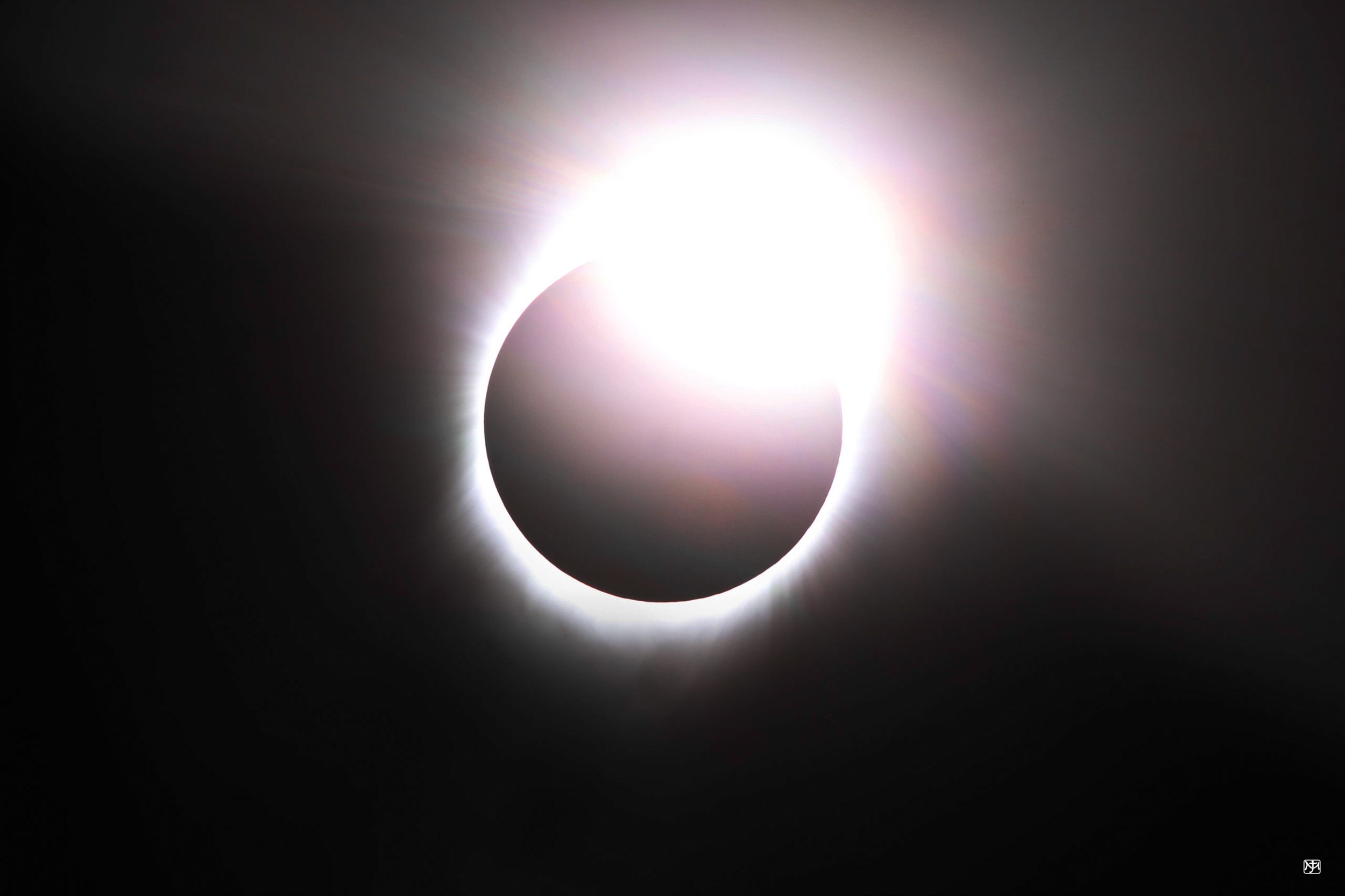#9 - Mapping Maine’s Total Solar Eclipses-60 years apart
John and Cathy create a postcard to honor Gus Phillips
and celebrate the April 8, 2024 solar eclipse in Maine
Cathy Jewitt, Author & Editor
John T. Meader, Photo & Content Editor
Gus’s 1963 Maine eclipse postcard on left. John and Cathy’s 2024 Maine eclipse postcard on right.
Using his art and cartography skills, Gus worked over the winter of 1962-63 creating a new postcard to celebrate that summer’s upcoming solar eclipse. By that spring, orders for his Maine lighthouses and Moosehead Lake postcards were flooding in, and he thought an eclipse postcard might also be a good seller. It was. Between March 1st and June 1st, he delivered more than 30,000 eclipse postcards to businesses across Maine.^1
Sixty-one years later, on April 8, 2024, another solar eclipse will pass through Maine. Totality takes a different path through the state than the 1963 eclipse did. The next opportunity to experience a total eclipse in Maine will not occur until 2079. The 2024 eclipse path passes through the Rangeley Lakes, Jackman, Moosehead Lake, Baxter State Park, Katahdin Woods and Waters National Monument, and several Aroostook County communities. If the excitement for the 2024 eclipse is anything like that experienced in 1963, then Maine will be a popular destination for visitors, astronomers, and photographers from across the northeastern US and Canada.
To commemorate both Gus’s artistry and the upcoming April eclipse, Cathy and John have produced a new postcard to honor Gus’s vintage card. John plotted the 2024 path-using the same map Gus used for his eclipse card-and created a new hybrid Phillips-Meader postcard.
Eclipse postcard backs, 1963 above and 2024 below.
That winter Gus also created a second eclipse postcard showing the eclipse’s path across all of North America. This card never proved as popular as the Maine card. For collectors, this is the more difficult find.
Gus’s 1963 postcard of the eclipse path across North America.
Gus’s Camp Natarswi postcard #355.
(NATure-ARchery-SWImming, a Girl Scout camp established in 1936 and still in operation.)
Cathy is Gus’s granddaughter. In the summer of 1963 when Cathy was a camper at Camp Natarswi near Katahdin, Gus surprised her with a visit. He gave her packets of eclipse postcards to hand out to all the campers and counselors. Her grandfather’s unannounced stop to spend the afternoon with her made that summer’s eclipse even more special. When July 20th came, everyone gathered outside their tents and used pinhole projectors to safely view the eclipse. Since Natarswi was outside the path of totality, Cathy and her friends saw only a partial eclipse which always requires eye protection. Knowing that she couldn’t look directly at the sun, Cathy remembers turning her back to the sun, and holding two paper plates in her hands. Earlier she had punctured the top plate with a needle, creating a pinhole that worked like a lens. As sunlight shined through the pinhole, a small image of the sun was projected onto the second paper plate. This method allowed Cathy and all the campers to safely watch the moon cover the disk of the sun. As she watched the sun being erased by the moon on the paper plate, Cathy had the eerie sensation that the world around her had paused as dusk fell, the air stilled, and the birds stopped calling that afternoon.
There are many types of pinhole projectors that allow one to safely observe the sun or an eclipse.
Photograph by John Meader.
John is the owner/director of Northern Stars Planetarium which has been presenting educational astronomy presentations to schoolchildren since 1987. Perhaps John’s earliest astronomical memory is of the 1963 total eclipse. Four years old at the time, he remembers his father taking him outside and holding his head firmly between his two hands, “Are you ready?” his dad asked. Then he turned John’s head so he could get a glimpse of the eclipse, then quickly turned him back away from it. “Did you see it?” “Yeah,” John replied. “Now don’t look at it again,” his dad retorted. John doesn’t claim to remember seeing the eclipse, but he firmly remembers his dad’s big hands on each side of his head turning his gaze into and away from the eclipse, and the stern response to not look at it again!
The mechanics of a solar eclipse. Graphic courtesy of NASA.
In August 2017, John and his wife Laura traveled to Wyoming for the total eclipse. Having taught the mechanics of eclipses in various planetarium shows since 1979, and having viewed several partial-eclipses and the annular eclipse of 1994, John was intellectually prepared, though not emotionally prepared, for the impact of totality. Both he and Laura were moved to tears. As eclipse chasers often say, “the difference between a partial eclipse and a total eclipse is like the difference between a lightning bug and a bolt of lightning!”
Types of eclipses, photography and graphic design by John Meader.
To safely observe the partial phases of an eclipse, it’s imperative that you wear eclipse glasses.
Graphic courtesy of NASA.
As with all eclipses, planning for such an event requires advance hotel reservations, weather reports, and of course, eclipse glasses. While eclipse glasses are necessary during all partial phases of the eclipse, during actual totality it’s perfectly safe to observe the event directly. That’s the only time you can witness the majesty of the Sun’s outer atmosphere, the corona. And the corona reveals a new pattern with each eclipse, making each event unique in appearance.
Totality reveals the solar corona. Each eclipse reveals a new view of the corona, as the constant solar wind changes the corona’s form over time. Photograph taken by John Meader in 2017 at Glendo, Wyoming.
In 1963 many small towns that were not accustomed to a high volume of tourists predicted that the eclipse would be good for business. The state’s economic office initially predicted that Maine might see an influx of ten thousand visitors on the days before and after the July 20th eclipse. However, as reservations for lodging began pouring in, the number was revised to two hundred fifty thousand.
Paul Knaut Jr.’s 1963 postcard of Dexter, Maine, collection of the author.
In Dexter, a town between Bangor and Greenville, residents agreed to postpone their usual 4th of July celebration and instead hold an “eclipse week-end,” complete with “a fishing derby, barbecues, dances, and various get-togethers in true Maine style.” The visitors were reported to be so numerous that many had to be housed in private homes.^2
F.G. Hills’s 1932 New England eclipse map,
collection of the author.
The only other 20th century total eclipse in Maine took place on August 31, 1932. And it turns out that when Gus created his map of the eclipse path across the state, he was following a tradition that goes back at least to 1932. That year F. G. Hills created a New England eclipse map and had it printed in Boston. Hills, like Cathy, noted that “The birds quiet their singing and all wild things are much perplexed by darkness coming at such a time.”^3
Whether viewing the 2024 eclipse becomes a unique experience in your life or it ignites a passion to chase other eclipses across the globe, it’s an event that you will always remember. Gus anticipated people’s desire for a memento of the day by creating his 1963 postcard. John and Cathy continue the tradition with their 2024 card. Once again, we connect with Gus, this time 60 years after his efforts to commemorate the 1963 eclipse.
A composite image of the Great American Eclipse of 2017 as seen from Glendo, Wyoming.
Photographed and created by John Meader.
Photographer’s Notes—John T. Meader
Having traveled to Wyoming in 2017 to both see and photograph the Great American Eclipse that August, as well as having witnessed and photographed numerous partial eclipses, I have become an eclipse chaser and photographer. My experiences can best be shared through a sampling of my photographs taken over the years while chasing the Moon’s shadow.
Solar eclipse sequence. Photo courtesy of John Meader.
Endnotes:
1. Augustus Phillips: handwritten entries in notebooks and receipts, 1963, collection of author.
2. Isabel Currier, Photographs by Marion Bradshaw, “Maine’s Moment in the Sun’s Eclipse,” Down East, July, 1963, link.
3. F. G. Hills, “A Map Showing the Total Eclipse of the Sun by the Moon across New England from the Northwest,” Boston, MA, 1932, collection of author.
Special thanks:
The Penobscot Marine Museum and Photo Archivist Kevin Johnson, for preserving the Phillips Collection, and continued support; Mary Jane Phillips Smith, Gus’s daughter, for sharing family history; Rhumb Line Maps for technical support and hosting; and John Meader for photography.
The 2024 Eclipse Postcard is available for purchase at:
The Penobscot Marine Museum Gift Shop in Searsport, Maine
The Osher Map Library, University of Southern Maine, Portland, Maine.
The Versant Power Astronomy Center, University of Maine, Orono, Maine
The Children’s Book Cellar, Waterville, Maine
Red Moose Gifts, 14 Main St., Patten, Maine
Patten Lumbermen’s Museum, Patten, Maine
Jefferson Market and General Store, Jefferson, Maine
Coming soon to other Maine locations
Partners for the Postcards from Gus blog:















